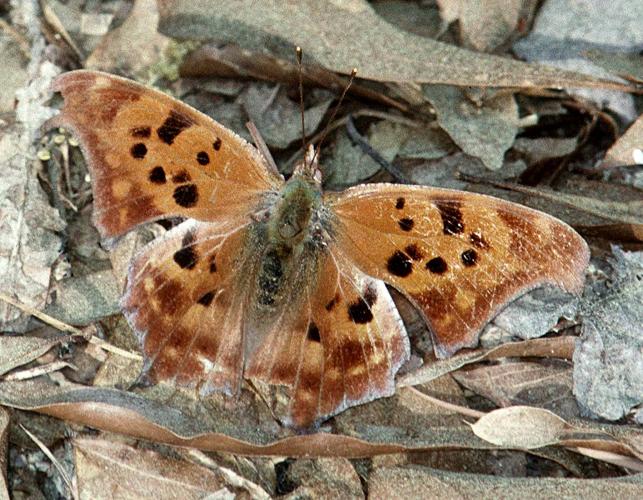
The question mark butterfly is named for the shape of the small silver mark on the lower side of the hindwings. It flies in Missouri April to November.
Adults: The three Missouri anglewings with irregular wing margins are most easily identified by the small silvery “punctuation marks” on the lower surface of the hindwing. The question mark is the only species with a dot next to the curved line. The upper side of the wings is orange with black markings. Note the row of three black spots on the forewing with a black line (like a hyphen) over the spot closest to the wingtip; the line is missing on the eastern and gray commas (P. comma and P. progne). The summer brood has the top side of the hindwing almost completely dark, while the overwintering fall brood has an orange hindwing, brighter markings, and violet-gray tails. Because the margin of the wings sometimes looks purplish, another common name is “violet tip.”
Larvae are spiny and yellowish to reddish brown with dark and light markings; the head has one pair of spines.
Wingspan: 2–2½ inches.

Statewide.
Habitat and Conservation
Found in forests, roadsides, parks, and residential areas. Look for them taking moisture from mud puddles, damp creek beds, and lake shores. Males perch on tree trunks to search for females late in the afternoon. They fly at passing butterflies, other insects, and even birds, generally returning to the tree trunk or a nearby perch. They may be pursuing territorial intruders or simply getting close enough to determine whether or not it is a female question mark.
Food
Host plants for the larvae include species of elm, hackberry, and nettles. The adults rarely visit flowers, but they absorb moisture and nutrients from damp soil, decaying fruits, feces, and carrion.
Status
Breeding resident.
Life Cycle
Adults fly from April into November. The fall brood hibernates, and the overwintering adults may fly on any warm winter day.
Human Connections
Charles Darwin wrote about the survival value of animal camouflage in the middle 1800s, but camouflage wasn’t widely used for military purposes until a French Cubist painter, André Mare, developed it to hide artillery in World War I. Now, people study nature expressly for ideas for new technology.
Ecosystem Connections
The caterpillars are herbivores that graze on vegetation. Their spines help ward off potential predators. This butterfly, like many of its relatives, has a well-camouflaged underside, plus a habit of resting that shows only the underside. This helps conceal it from predators.















































